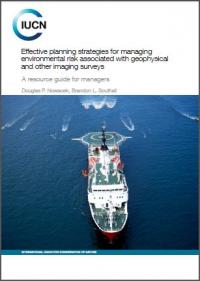BEAUFORT — A new guide, co-written by a Duke University professor, has been released in an effort to help energy companies and governments reduce the potential harmful effects of underwater seismic surveys on marine life.

Doug Nowacek, a professor at the Duke Marine Lab whose research focuses on the effects of sound on ocean animals, said the guide, published by the International Union for Conservation of Nature, is intended as a practical tool for those who use intense impulses of compressed air to search for oil and gas under the sea floor.
Supporter Spotlight
“We were trying to be really pragmatic,” said Nowacek, who co-authored the guide with Brandon Southall of Southall Environment Associates Inc. and the University of California at Santa Cruz.
“If you live on the coast of North Carolina, that can be a little hard,” Nowacek said, given current sentiments. “But if it (seismic surveying) is going to happen, our thought was, we should help those who are going to do it do it as responsibly as possible, with the fewest possible impacts.”
In seismic surveys, air guns towed behind ships emit bursts of sound under the water over long periods of time and large distances. Onboard sensors then measure the sounds’ return echoes to reveal details of the sea floor and its underlying geologic structure.

The International Union for Conservation of Nature, founded in 1948 in France and now based in Switzerland, works in nature conservation and sustainable use of natural resources. It is involved in data gathering and analysis, research, field projects, advocacy, lobbying and education. The union’s mission is to “influence, encourage and assist societies throughout the world to conserve nature and to ensure that any use of natural resources is equitable and ecologically sustainable,” according to its website.
The guide, “Effective planning strategies for managing environmental risk associated with geophysical and other imaging surveys,” came out in early September. While the Obama Administration this year pulled the Atlantic Ocean out of the 2017-22 offshore oil and drilling plan, the federal Bureau of Ocean Energy Management, or BOEM, has not pulled the plug on seismic testing.
Supporter Spotlight
The work on the guide grew, in part, from two papers Nowacek previously wrote, one in 2013 and the other two years later. The union, Nowacek said, thought the work was good, but “not very accessible” for individual managers. So the idea behind the new guide, he said, was to create something that could be used by companies preparing to do a seismic survey.
To that end, Nowacek and Southall engaged in a comprehensive review of literature on the subject. “Our guide is based on the best available science and methods,” Nowacek said. “It draws on observations of operations and associated monitoring and mitigation efforts over several decades of geophysical and other industrial surveys.”

Nowacek had the draft of the guide reviewed by anonymous experts, as well as by peers, including representative of non-governmental organizations and industry.
The new guide recommends the assessment of the potential risk of various surveys on marine life and emphasizes that surveys must take into account the specific circumstances related to the site. Key factors for consideration include the life history and population status of local species, environmental features and history and nature of other operations in the area.
Some of the guide’s key recommendations include:
- Having a systematic, risk assessment-based means of conducting effective monitoring and mitigation;
- Reducing the survey area and sound source transmissions to the minimal size necessary;
- Using the smallest source (e.g., smallest number/size of air guns) necessary to accomplish the exploratory goal;
- Avoiding redundant surveys in the same area;
- Pursuing alternative, lower energy sources;
- Ensuring transparency and dialogue with interested stakeholders as well as open access of environmental data in a reasonable time frame.
All of those, Nowacek said, are good precautions for marine mammals, which depend so much on hearing for navigation and for feeding, as well as for pinnipeds, turtles, fish and possibly other marine creatures able to hear the loud sounds produced by seismic surveys.
But the recommendations, he said, could also benefit the companies doing the surveys by reducing conflicts with environmental and conservation stakeholders. It could save time, and time is important when companies are planning extensive surveys that cost considerable amounts of money.

Nowacek said the guide tries to present this risk-assessment as just another part of responsible planning for a project, not as a sore thumb that sticks out, but as something that managers could, in a sense, “sell” to superiors who make the decisions.
Southall put it this way in a press release: “Undertaking a structured approach for planning and conducting environmentally responsible seismic surveys and other forms of seabed mapping is now more feasible than ever thanks to the lessons learned from previous operations, sustained research, and improvements in technology. This guide will help managers and policymakers navigate this process.”
The guide, Nowacek said, also includes a comprehensive extensive online resources that will continue to be updated.
In the news release, Carl Gustaf Lundin, director of the union’s Global Marine and Polar Programme, praised the guide. “The noise from seismic surveys can disrupt the essential life functions of marine species, such as breeding, nursing and foraging,” he said. “It is therefore critical to turn down the volume and ensure the surveys are conducted in an environmentally responsible way. The new IUCN guide will help in achieving this.”
Seven companies have pending applications for seismic testing in the Atlantic, according to the BOEM website.
A bill has been introduced in Congress, aimed at protecting the Atlantic from such activities. The Atlantic Seismic Airgun Protection Act is sponsored led by Sens. Cory Booker, D-NJ, and Robert Menendez, D-NJ and by Reps. Don Beyer,D-VA, and Frank LoBiondo , R-NJ in the House.
It would impose a moratorium on geological and geophysical activities related to dangerous oil and gas exploration along the East Coast.
Grassroots efforts against seismic testing have also continued. More than 1,100 elected officials, roughly the same number of businesses and fishing groups have publicly opposed offshore drilling and seismic testing. Many towns in coastal North Carolina have adopted resolutions of opposition.

Nikki Martin, president of the International Association of Geophysical Contractors, wasn’t very impressed with the guide. Her trade group represent companies that acquire or process geophysical data, equipment manufacturers, industry suppliers and consultants.
“The IUCN guidance appears to rely on only one source of management information and fails to consider a breadth of regional and international sources of environmental management information,” including the United Kingdom, NOAA, Brazil, Ireland and New Zealand, she said. “The authors of this particular ‘guidance’ are not sufficiently expert in all necessary subjects needed for a well-informed decision-making and planning document.
Martin said not enough time was provided for comment and experts were not convened to offer technical input” Martin added. “It is especially important to take into account the experience of five decades of seismic exploration in the oil and gas industry and more than a decade of dedicated research into potential effects of seismic surveys on the environment,” she said
Nowacek said he and Southall considered every national and international source of management information. “We recognize that nobody can be an expert in everything, which is why we solicited input from industry, NGO and government folks who represent varying expertise and experience,” he said.








